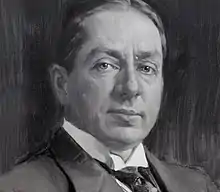Walter H. Cottingham
Walter Horace Cottingham (8 January 1866 – 12 March 1930) was a Canadian businessman who led the global expansion of Sherwin-Williams Company as the second president and chairman from 1909 to 1930.[1][2]
Walter H. Cottingham | |
|---|---|
 | |
| Born | Walter Horace Cottingham January 8, 1866 |
| Died | January 8, 1930 (aged 64) Berkshire, England |
| Resting place | Lake View Cemetery, Cleveland, Ohio |
| Occupation | Businessman |
| Known for | Second president of Sherwin-Williams Company |
| Spouse | Gertrude Bennett |
| Children | 3 |
Cottingham was also the owner and chairman of Lewis Berger & Sons as well as the director of the Cleveland Box Co., Ozark Smelting Co., and the Cleveland Trust Company.[3][4]
Early life
Cottingham was born on 8 January 1866 in Omemee, Canada West to an English father and an Irish mother.[3][4] At the age of six, his mother died. His father passed away as well two years later.[4]
After the death of his parents, Cottingham started to live with his sister and was received education from public schools.[4] He also started working as a clerk in a hardware shop in Peterborough, Ontario, when he was fifteen years old.[4] Following year, he moved to Montreal where he worked in a hardware and paint store for four years.
Career
Walter Cottingham, then 21 years old, started his own business manufacturing gold paints after purchasing the formula for $25.[4] In 1891, he organized his business as Walter H. Cottingham & Company.[4] He became the Canadian agent for Sherwin-Williams & Company in 1892, which led to the establishment of Walter H. Cottingham Co. to manufacture Sherwin-Williams products in Canada.[4]
In 1896, Cottingham engineered a merger between his own company and Sherwin-Williams & Company. He was appointed to the board of directors and the manager of the Canadian branch.[4][3] Two years later, Cottingham was brought to Cleveland by Henry Sherwin and Edward Williams to become the consolidated company's general manager.[3][5] In 1903, he was added the title and responsibilities of vice president.[3]
In 1909, Cottingham was elected as the second president of Sherwin-Williams after the retirement of Henry Sherwin.[1][5] During his tenure, Sherwin–Williams' revenues grew from $2.3 million to $34.2 million, generated by 600 different products. In 1917, under Cottingham's leadership, the company purchased the Chicago-based Martin-Senour Company.[1] The corporation went public three years later, in 1920, with the sale of $15 million in preferred shares.[1] The proceeds from the transaction were used to buy the Detroit-based Acme Quality Paint Company, as well as a new plant in Oakland, California, and expand several existing operations.[1]
Throughout his career, Cottingham worked hard to motivate his employees to reach their full potential.[1] Cottingham was skilled at launching effective sales campaigns.[1] He was also a writer and orator who published a number of "inspirational" editorials and writings on various topics.[1]
In 1922, Cottingham resigned from the presidency to become chairman of the board and was succeeded by George A. Martin as the third president.[1][4] Cottingham moved to his estate, Wooley Hall, in Maidenhead, England and managed his business interests including Lewis Berger & Sons.[4]
In March 1930, he died in Berkshire, England.[6] He was interred at Lake View Cemetery in Cleveland, Ohio.[4]
Personal life
On May 22, 1888, Cottingham married Gertrude Bennett and they had four children: Gladys, Gertrude, Sherwin (who later married Maggie Teyte), and William.[4]
References
- "The Sherwin-williams Company". Encyclopedia.com.
- "Sarah Fay Weds W. S. Cottingham". October 9, 1983 – via NYTimes.com.
- "How His Dream Was Realized | Maclean's | JULY 1908". Maclean's | The Complete Archive.
- "Walter Cottingham - Bratenahl Historical Society - Bratenahl, Ohio".
- "SHERWIN WILLIAMS CO". Encyclopedia of Cleveland History | Case Western Reserve University. January 10, 2022.
- "WALTER H. COTTINGHAM.; Head of Sherwin-Williams Interests Dies in England". March 13, 1930 – via NYTimes.com.